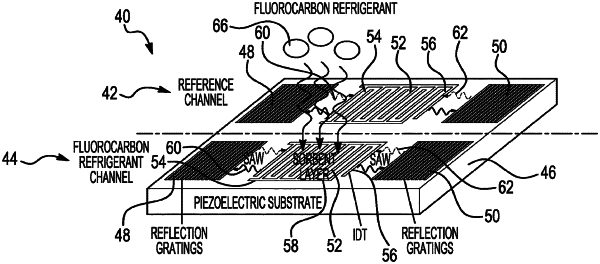| CPC G01N 29/022 (2013.01) [G01N 2291/0256 (2013.01); G01N 2291/0423 (2013.01)] | 8 Claims |

|
1. A surface acoustic wave (SAW) sensor for sensing a refrigerant comprising:
a piezoelectric substrate that is delineated into a reference channel and a refrigerant channel;
the reference channel comprising a first interdigitated transducer deposited on the piezoelectric substrate, the first interdigitated transducer having an input portion that receives input surface acoustic waves and an output portion that emits output surface acoustic waves;
the refrigerant channel comprising a second interdigitated transducer deposited on the piezoelectric substrate, the second interdigitated transducer having an input portion that receives input surface acoustic waves and an output portion that emits output surface acoustic waves; and a refrigerant sensor film located between the input portion and the output portion of the second interdigitated transducer, the refrigerant sensor film including a sorbent material that is selected for preferential adsorption of a target refrigerant over atmospheric gases;
wherein in the refrigerant channel adsorption of the target refrigerant by the sorbent material results in a frequency shift of a frequency of the output surface acoustic waves relative to a frequency of the input surface acoustic waves, and in the reference channel there is no frequency shift of a frequency of the output surface acoustic waves relative to a frequency of the input surface acoustic waves;
wherein the sorbent material is a metal organic framework (MOF) material that is generated from an organic building unit and a metal center including one of alkali, alkaline, transition, lanthanides and actinides with 2+, 3+ and 4+ oxidation number, and the organic building unit includes one of 1,4-beneze-dicarboxylate, 1,3-benzene-dicarboxylate, 1,2,4,5-beneze-tetracarboxylate, 1,3,5-benzene-tricarboxylate, 4,4′-sulfonyldibenzoate or an organic macrocycles; or
wherein the sorbent material is a covalent organic framework (COF) material.
|